
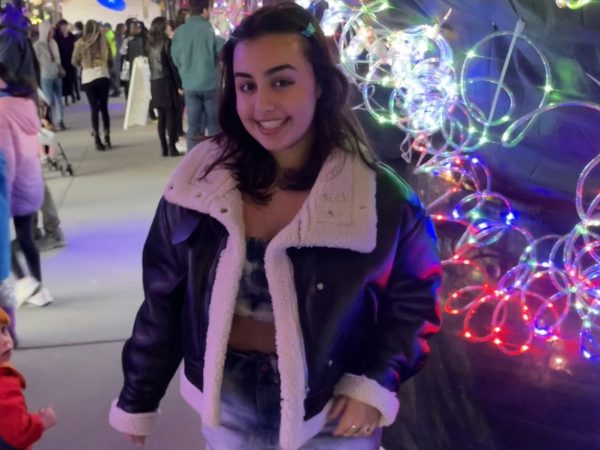

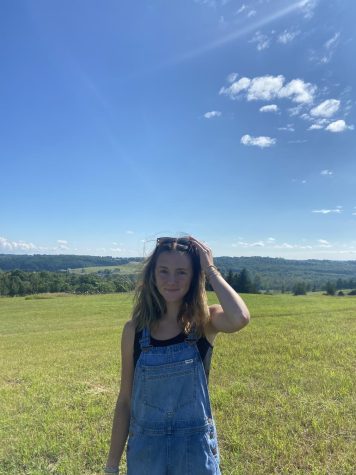
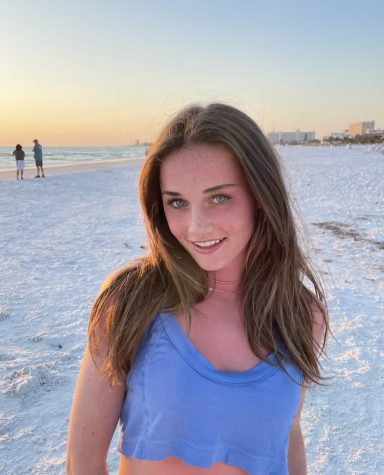
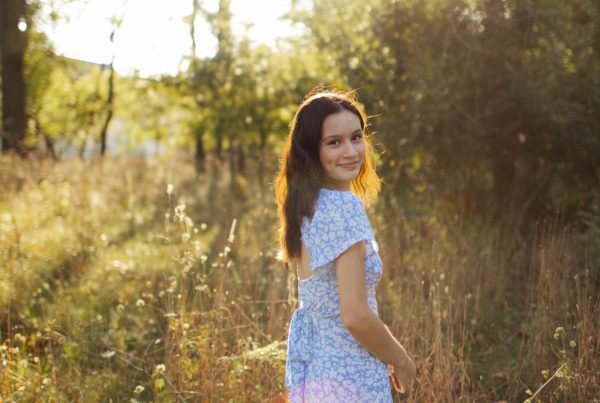

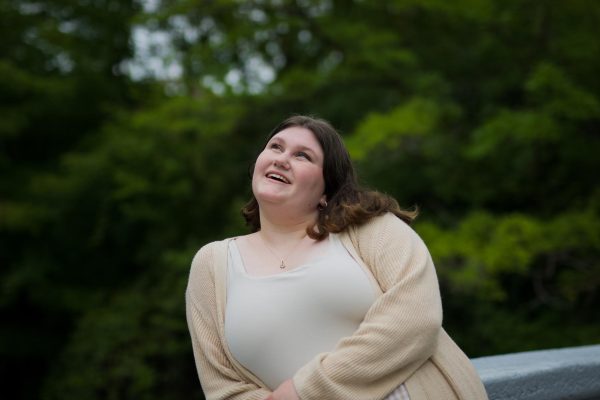
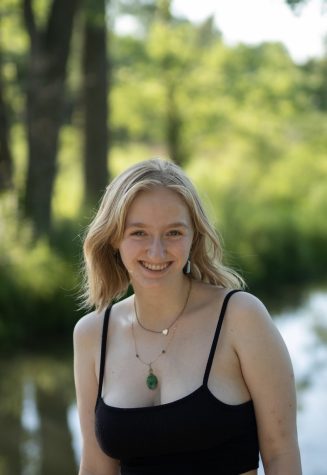
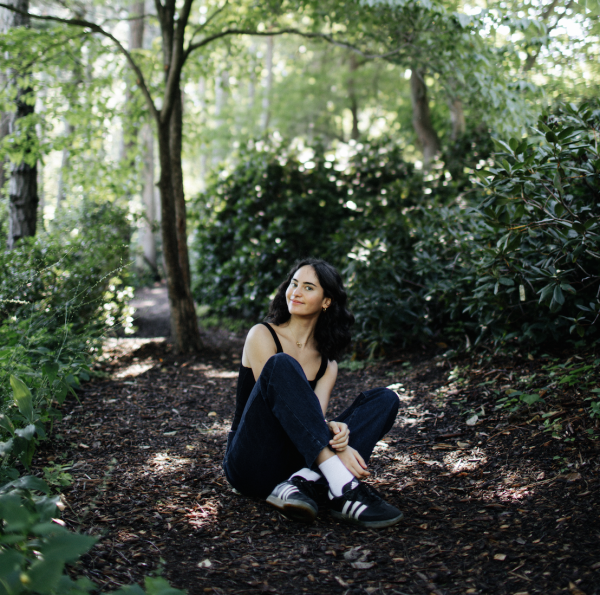
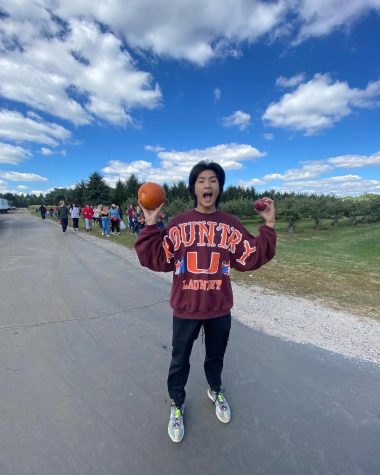
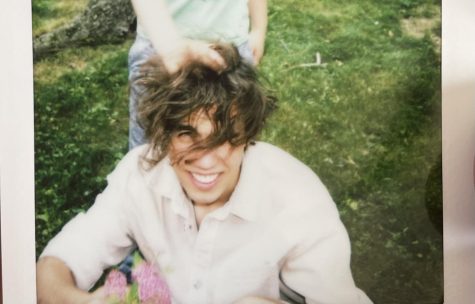
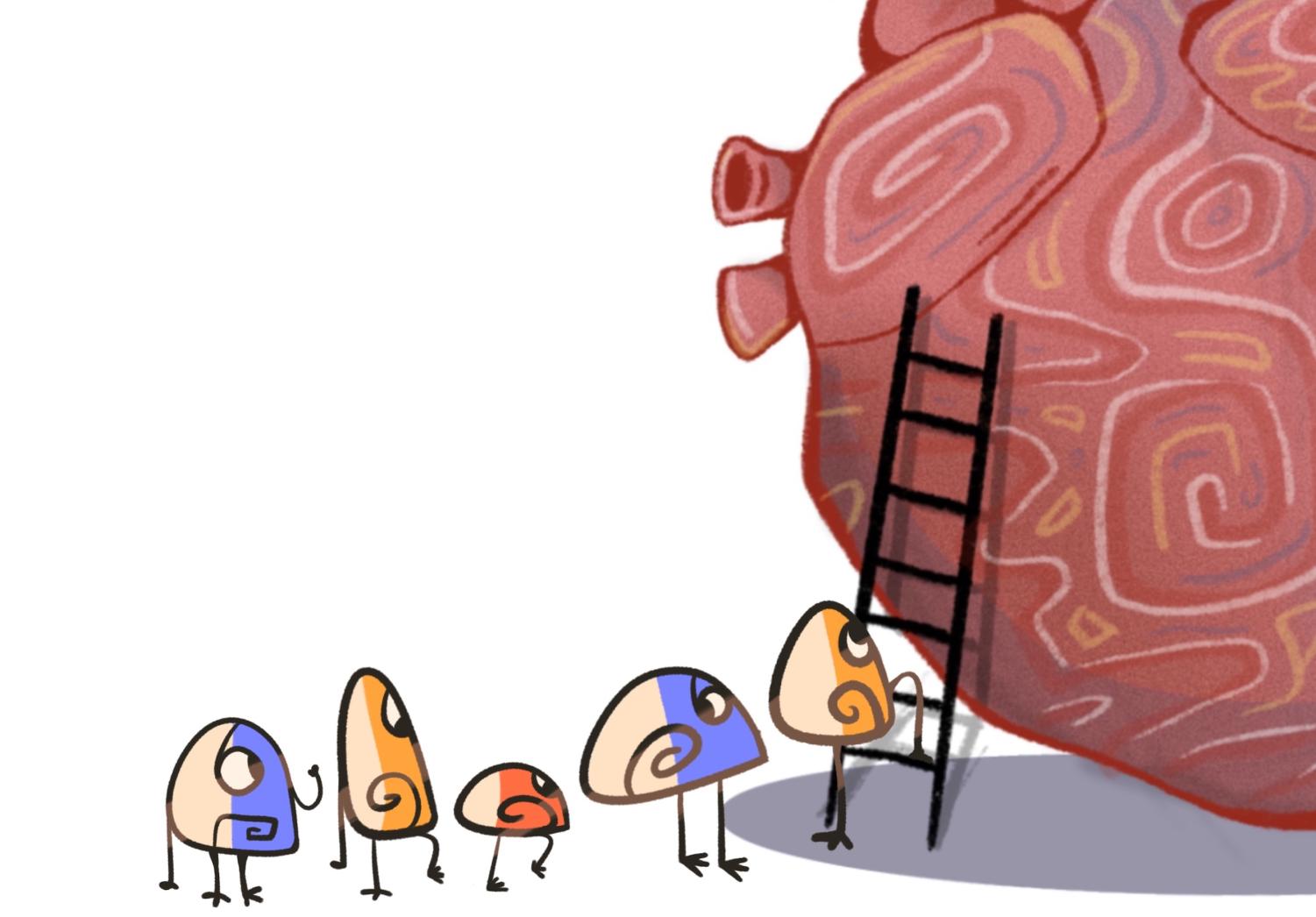

January 12, 2023
Healing is happening all around us. With this story package, we hope to capture the stories of our community with twelve CHS student and staff feature stories.
A CHS Senior rides the ups and downs of self discovery and learning to live for herself.
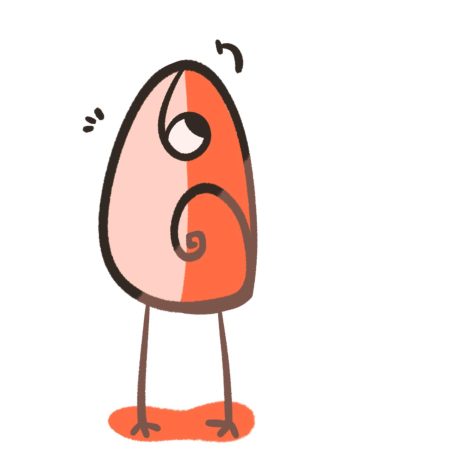 Hannah Margolis walked with her head buried in her books through the hallways trying to avoid eye contact with everyone.
Hannah Margolis walked with her head buried in her books through the hallways trying to avoid eye contact with everyone.
She spent her freshman year wanting to stay out of other people’s business in the hope that they would stay out of hers. As an introvert, Margolis struggled with her self-image and confidence.
When Margolis first stepped foot in CHS, she didn’t have many friends. Most of her middle school friends went to their designated high school and she felt out of place.
“I didn’t have the confidence to go up and meet anyone,” Margolis said. “I just remember walking down the hallways, holding my school stuff, looking down and trying not to make eye contact with anyone.”
Her mind was filled thinking about the opinions of others so she learned to keep to herself, even though that wasn’t how she wanted to live.
“I thought every time I walked past someone they were thinking badly of me,” Margolis said. “I was always thinking something negative about myself and my confidence got worse from there.”
With age, Margolis’s confidence bloomed. Gaining confidence was not linear for Margolis, but the process began unintentionally. Halfway through her freshman year, the pandemic took over her life. She was forced to spend time alone — something that unexpectedly benefitted her. She had time to work on herself and acknowledge the things she didn’t like about who she was. Recognizing those things and viewing them in a positive light changed her perspective and her confidence grew.
Once Margolis became aware of the improvements she wanted to make, she worked toward spending less time on her phone. She acknowledges the benefits of social media, but it forced her to think she had to go out and hangout with friends all the time. Taking time away from her phone showed her that she didn’t need other people’s company — that it was okay to be home alone on a Friday night.
She began taking more time for herself and doing things she enjoyed: washing her face every night, picking out an outfit the night before school, making her bed in the morning and other smaller aspects of her life that she found fulfilling. Once she felt happy and more put together, it reflected in the way she held herself.
“I’m not worried about what I have to wear to impress other people,” Margolis said. “I’m not trying to impress and satisfy everyone else. I just want to look good for myself. I want to feel good for myself and when I do, I don’t care what people think about it anymore. If I like how I look and I like how I feel, then it doesn’t matter how other people see me at all.”
This mindset change helped her move into a more positive lifestyle. As Margolis began to feel more secure with herself, she could feel the negativity slowly leave her mind.
“You don’t have to love everything about yourself, but you don’t want to dwell on those things,” Margolis said. “Healing is not a smooth process and is not a measurable thing, but I think I’m finally at the point where I’ve healed.”
A CHS senior overcomes multiple concussions along the path to collegiate soccer
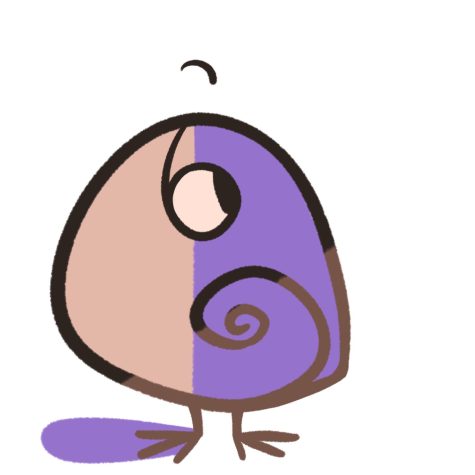 Bella Stevens experienced her first concussion at the age of eight years old. Five concussions later, the now CHS senior has committed to play soccer at a top tier school.
Bella Stevens experienced her first concussion at the age of eight years old. Five concussions later, the now CHS senior has committed to play soccer at a top tier school.
Stevens continued to play through concussion after concussion, until she was finally forced to stop. During her junior year, Stevens experienced a secondary concussion and additional brain trauma all within the month of Sep.
After the initial concussion, Stevens experienced a constant headache with little to no relief. After the second one, she struggled with basic reading and listening comprehension.
The severity of these symptoms should have forced her to pause competing in soccer. However, Stevens’ coaches wanted to win, this meant Stevens in the goalie position.
The first few matches of the season would be essential to securing the team’s spot in high level tournaments. Stevens refused to throw away everything she had worked for during pre-season.
Unfortunately, during one of these showcase matches, Stevens took a blow to her cerebral cortex. She began to experience extreme derealization which would evolve into depersonalization throughout the following months. Stevens attempted to vocalize her concerns, but coaches refused to take her seriously insisting that she continue to play.
“I couldn’t view the world the same,” Stevens said. “I didn’t feel real and the world around me didn’t feel real.”
When it comes to healing from a concussion, Stevens was told by her doctors that they had little information on the process. They explained that recovery would vary from person to person, and Stevens would need to feel it out for herself.
“In the beginning, I was right there with [my coaches] pushing myself,” Stevens said. “I was actually pushing myself more than them.”
As she continued playing, Stevens’ executive function and physical condition deteriorated. Against the wishes of her head coaches, a goalie training coach forced her to stop. During practices, this coach noticed Stevens struggling to stand or even make it through warm-up drills.
Stevens was benched for nearly two months, missing showcase matches and countless recruitment opportunities. Without support from her coaches or teammates, Stevens was falling out of love with soccer altogether.
If Stevens was going to get her life back, something needed to change. It was during this low point that Stevens met someone, her now girlfriend, who reminded her that healing was worth it. This built the motivation to get her grades up and rebuild her mental and physical health.
Stevens began changing her coping mechanisms and doing everything in her power to further her recovery. Whether it was hours or PT or constantly tracking her BPM. Slowly, Stevens did heal. Although the damage done to her brain would never fully disappear, Stevens was able to start training for soccer again and keep her grades up in school.
Stevens learned three main tools to aid the healing process: time management, prioritizing recovery and planning ahead. Stevens attributes her recovery to these skills and believes they will be the key to success in college as well as the rest of her life.
In late April of her junior year, Stevens had a skate-boarding accident that resulted in her most recent concussion. Although she was initially terrified of losing all of her recovery progress, Stevens soon discovered that this injury would not set her back. She would not slip into another patch of demotivation and depression.
She would push through this injury straight till the end of her season. College soccer had been pushed to the back of Stevens mind, until an un-passable opportunity presented itself.
Stevens was offered a position at her dream college—a top tier school. After overcoming six brain injuries, Stevens is committed to play soccer in college.
Violet Knyal learns how to grieve over someone she feels like she never truly knew.
 Violet Knyal felt a pain that other kids her age didn’t understand: going through childhood with one parent being unable to witness it. Being only two years old when her father, Jarrett, passed away, Knyal felt like she never truly got to know him. With the lack of understanding from her peers, she often felt her pain and struggles weren’t valid.
Violet Knyal felt a pain that other kids her age didn’t understand: going through childhood with one parent being unable to witness it. Being only two years old when her father, Jarrett, passed away, Knyal felt like she never truly got to know him. With the lack of understanding from her peers, she often felt her pain and struggles weren’t valid.
“I feel like I can’t grieve, or I can’t feel bad about the fact that he’s not here,” Knyal said. “But I’ve been trying to feel like I can heal from that… I’m allowed to feel sad.”
Knyal heard her father’s voice for the first time recently, and that moment in particular stood out to her in the grieving process.
“I heard his voice for the first time. In a video, which was kind of a lot,” she said. “I think I started crying.”
Knyal’s healing process typically contains a lot of humor. She finds that joking about her situation helps her manage it. She also enjoys baking, listening to music and finding various ways to distract herself.
Despite these distractions, Knyal occasionally finds herself faced with the thought of what could’ve been.
“I could have felt like I had a biological father at some point,” Knyal said. “But I also think about the fact that a lot of things in my life would’ve been different. Would it be better if he was here? Where would I be now?”
In addition to feeling a certain disconnect from her father, Knyal also worries for her family. She thinks of her mother in particular, and how emotionally taxing it was for her to lose her husband.
“I think that sometimes I heard her crying in her room, and I felt like it was about him,” Knyal said. “It must have been really difficult because she had just given birth to me, like, not that long ago. And she had to think about the fact that she had to raise two kids.”
But on her healing journey, Knyal learned that memories don’t end when a life does.
Knyal’s family has done everything in their power to make sure that Jarrett Knyal wouldn’t be forgotten.
“My mom was really good about telling me about him,” Knyal said. “I’ve learned a lot of things [about him]. I’ve seen pictures… [My mom] doesn’t hide him from me.”
Her family helped keep the memories of her dad alive, but Knyal wishes those memories were her own. “
I feel jealous of my family,” Knyal said. “Because they knew him and got to live with him.”
Although Knyal doesn’t have those memories herself, she still keeps thoughts of her father with her everyday. Jarrett Knyal’s memory has continued to carry on through those that cared about him. Through his twin brother, who would travel to Ann Arbor to celebrate his birthday with Knyal’s family, and Knyal’s mother, who shows her photographs and tells her stories. No matter what, small pieces of her father will always remain with her.
A CHS senior processes the effect her adoption had on her identity.
 “I was nine and thinking that there is something seriously wrong with me,” Gabbi Anderson, CHS senior, said.
“I was nine and thinking that there is something seriously wrong with me,” Gabbi Anderson, CHS senior, said.
Anderson is adopted from Guatemala, and when she was nine she went to meet her biological family: her biological grandma and biological siblings.
After coming home, she was confused and hurt. Her mother had other kids, before and after her, and only put her up for adoption, and, especially as a nine-year-old, this was difficult to understand. Anderson worked on healing from this experience with her parents and therapist, but when she was 14 she was all the progress she had made was lost after a Facebook message to her biological mom.
The message read, “Gabbi is interested in flying to Texas and seeing you. Would you be interested in that same sort of thing?”
The response was a thumbs-down emoji.
That one symbol response held the power crush Anderson in an instant. She restarted her healing process after this. She started talking to her mom more about her feelings related to her adoption. Anderson was finally able to be open and explain how she felt after visiting Guatemala and how she felt after receiving the response. With time, she no longer wanted to meet her biological mom and was satisfied and happy in her life in Ann Arbor with her parents and two brothers who are also adopted.
“My family is here, and my family is the people that I live with, the friends that I have [and] the connections I’ve built here,” Anderson said. “Adoption is a loaded topic that people don’t really understand unless you yourself are adopted, and it’s different for everybody. It was such a huge realization for me and just to say I thought there was something wrong with me and to talk about things with her really changed my life.”
Anderson admires her parents for having children through adoption and believes that it takes strength to go on that journey. She recognizes it is challenging to adopt and raise kids, especially multiple kids with different stories and challenges. For many adopted kids, there can be a lot of confusion growing up and struggles with self-worth.
“It takes a strong parent, and a validating parent to raise [adopted children],” Anderson said.
With the help of her parents, Anderson has grown as a person and gained clarity on what she values in relationships. She has found she values having a small, trustworthy and tight-knit group of friends more than a larger friend group. Her friends remind her she is here for a reason and valued where she is.
In general though, Anderson feels tip-toed around when it comes to adoption.
“I feel like it’s always something that you have to say, and it’s a little bit taboo,” Anderson said. “People are afraid to ask [if I’m adopted] if I go out with my parents, but I think it’s something that I live with, so it’s normal to me, I wouldn’t be upset and people shouldn’t be afraid to ask about it because talking about it helps me process it and will help other people feel more comfortable.”
Anderson loves her family, friends, the connections and the life she has built in Ann Arbor and doesn’t have anything she feels is missing. She does not plan, or want, to meet her biological mom because she already has a team of people on her side and she is healing.
A CHS junior learns to accept an isolating allergy.
 Edison Hannahs took the risk and had grilled cheese with his friends. As soon as he put it in his mouth, he knew he shouldn’t have done it, but the taste was just too good. A few minutes after finishing it, his throat started closing up.
Edison Hannahs took the risk and had grilled cheese with his friends. As soon as he put it in his mouth, he knew he shouldn’t have done it, but the taste was just too good. A few minutes after finishing it, his throat started closing up.
“This was a huge mistake,” Hannahs said. “I felt like I was dying. The risk I put myself in for a grilled cheese was not worth it; I definitely learned my lesson that day.”
When Edison Hannahs was four years old, he tried a piece of cheese for the first time. After eating the thin slice of cheddar cheese, his mom noticed he was struggling to breathe. Hannahs was diagnosed with a dairy allergy. From that point on, he was on a strict no-dairy diet.
In kindergarten, while Hannahs’ classmates enjoyed large pieces of cheese pizza, his mom had to bring him his own slice of dairy-free pizza. He began noticing that his lunch looked different from his friends’; he had a plain cup of white dairy-free yogurt, while his friends had blue yogurt with characters from the newest movies. He hadn’t yet reached the age to understand why he couldn’t eat the foods that his friends did, leaving him to sit alone at the dairy free table.
“I was confused why I wasn’t allowed in the lunch lines to get milk,” Hannahs said. “All I wanted was some chocolate milk like the other kids.”
As Hannahs got older, he began to understand why he was different. But there was one thing holding him back from accepting his difference, why did it have to be him who had the dairy allergy?
“Although I was aware that I couldn’t have dairy, it was hard for me to understand why it had to be me,” Hannahs said. “I felt left out. I wished I could have cookies, cheese and even something as simple as milk.”
Dairy was all around him. His friends regularly enjoyed dairy treats. Hannahs was done feeling so left out: he decided he would try dairy. He so badly wanted to be able to share those moments with his peers.
“All I wanted to do was fit in,” Hannahs said. “And if that meant testing my allergy and eating dairy, then I was willing to do it.”
As Hannahs entered middle school, dealing with his allergy was easier. He learned his limits and his friends began to understand the severity of the allergy.
“I still wished I could eat dairy, but I was finally not ashamed of it and I was happy my friends were aware of it too,” Hannahs said.
Hannahs, now a junior at CHS, has mostly grown out of his allergy. He can now enjoy baked dairy goods that he couldn’t have before.
“I’m glad I had to learn to accept something about myself at a young age,” Hannahs said. “Being deprived of something that everyone else around you gets to have is a tough pill to swallow for someone who’s too young to understand, but I’m glad I went through it.”
A CHS teacher carries the memory of her mother.
 Laurel Landrum held up a pair of little girls’ dresses covered in sparkly beads and lace flowers. Next, came a cowgirl costume in black and white cow print with red fringe. Then, a pair of cozy, woolen mittens. Landrum fished through the bag of items and smiled—her mother had made them.
Laurel Landrum held up a pair of little girls’ dresses covered in sparkly beads and lace flowers. Next, came a cowgirl costume in black and white cow print with red fringe. Then, a pair of cozy, woolen mittens. Landrum fished through the bag of items and smiled—her mother had made them.
In 2020 Landrum, a CHS teacher, lost her mother to ovarian cancer during the height of the pandemic and online teaching. For several years after the diagnosis, her mother had been in and out of treatments and that summer, the last treatment failed. As the world opens up, she looks to all the special things her mother did as a way of healing.
As COVID-19 restrictions were lifted after her mother’s passing, the family started to go out into the world and establish new family traditions.
“[We started] doing the things we would have done anyway, without her, ” Landrum said. “It was nice to have holidays and go on vacations together. That was helpful.”
Landrum’s mother was the center of many family activities. She hosted parties, bought gifts for the grandchildren and made things special. Now, Landrum and her sister are following in her footsteps as they take on this role. This past year they hosted Christmas and Thanksgiving. They also organized a family vacation and rented a house in Ludington, Michigan, where their parents grew up.
Her mother was not only a hostess but a skilled seamstress. Growing up in a very rural area meant that Landrum’s mother became a jill of all trades: she hand-made all of her own clothes and could mend almost anything. She would make holiday dresses and costumes for her daughters, “memory quilts” out of old t-shirts and stuffed animals. Now, a new generation will carry on this tradition. Landrum’s daughters are going to learn to sew and have slowly gone through the various fabrics and sewing tools their grandmother had set up in the basement.
“We signed the girls up for sewing lessons so they can learn to do it themselves,” Landrum said. “It took some time, but now we are able to do that stuff.”
Continuing these traditions is a way for Landrum’s family to carry on the memory of their mother, their grandmother and the amazing woman she was. Hosting a party or learning to sew are ways Landrum and her family heal. In healing, they are honoring their loved one, her legacy and light.
“All the things my mom used to do I took for granted before,” Landrum said. “I didn’t really think about how special it was that she did all those things until she couldn’t do them anymore. It feels special to be carrying on some of these traditions.”
A CHS social studies teacher strengthens his family relationships post-pandemic.
 “I think as a father one thing that the pandemic did was make my paternal instinct to make sure I was taking care of my wife and kids significant,” Brett Kilgore, CHS Economics and Geometry teacher said.
“I think as a father one thing that the pandemic did was make my paternal instinct to make sure I was taking care of my wife and kids significant,” Brett Kilgore, CHS Economics and Geometry teacher said.
For Kilgore, the pandemic caused him to focus on his devotion to his immediate family: his wife and three kids. He agonized over the socialization of his kids as well as their education. Coming out of the pandemic, though, he hopes to re-strengthen relationships with his own siblings.
“There was a lot of brokenness that happened [in my extended] family,” Kilgore said. “People were not getting along.”
Along with focusing on his extended family, Kilgore is working on himself and loved ones at home. He has begun to create a ‘margin’ for prioritizing time only to be spent on his kids. He has learned that scheduling out every hour of the day leaves little room for error. That room for error being: a kid getting sick, needing to pick someone up last minute, or needing to be home early for his kids while his wife is working.
Learning the power of not having a full schedule has helped Kilgore create space for things not to ‘crumble’. He believes that it is okay to say no to ‘good things’. Those things are opportunities that enrich Kilgore’s life but aren’t essential to his day to day schedule. He has found that in creating a ‘safety net’ for things to come up, he has found himself enjoying his life more than he has the past two years. It has allowed him to be fulfilled by the things that he has time to do, and not worry about the things he doesn’t have time for.
“It is easier to say ‘no’ right off of the bat,”Kilgore said. “It is much easier and more respectful than having to tell someone later that you can no longer do it.”
Kilgore also believes that CHS is in the healing process, as well as the reconstructing process. Through the pandemic the school went through major staff changes: teachers retired, switched schools, went into other professions, etc. CHS was also not able to continue with traditions while online learning was in place or when social distancing had to be practiced on a daily basis.
“I think seeing the finish line with construction is going to be a beautiful thing in terms of logistics,” Kilgore said. “Also Forum’s being able to really settle into their rooms and establish those routines will help bring back old traditions.”
Coming out of the throes of Covid, Kilgore anticipates that with re-establishing routines: trying to bring old ones back to life, as well as creating new ones will help ‘naturally’ bring people through the healing process.
With the first week of school being done, Kilgore was able to meet with the entire staff and connect through their very first meeting. He believes that the new group of individuals has a lot to offer and will each bring a lot to the table.
“If we can share this load [of teaching], get across some of those finish lines and be the best versions of ourselves for our students, I think that is when we can provide the best educational experiences.”
A CHS junior finds a community within CET.
 If Ebie Lamb wasn’t in Community Ensemble Theatre (CET), she doesn’t know where she would be.
If Ebie Lamb wasn’t in Community Ensemble Theatre (CET), she doesn’t know where she would be.
Lamb started theater in sixth grade at Tappan Middle School, and started to perform in seventh grade. That’s when she fell in love with the art.
Lamb decided to do a show again during her eighth grade year. On the day of her cast party, the production abruptly stopped due to COVID.
“We did our cast party, and then we were sent home,” Lamb said. “We never saw each other after that.”
CET helped heal her open wounds and find a sense of community once again.
Lamb started CET her freshman year on Zoom with “Working” the musical. Though her passion for theater was reignited, the virtual conditions were not ideal. Lamb sat in her kitchen every rehearsal in front of a green screen: creating relationships was not in the picture.
When sophomore year started in person, Lamb decided to audition for CET’s fall show, “She Kills Monsters.”
Lamb landed the lead, Agnes Evans.
“I was nervous because I felt that I had to make a good show. For some people, this would have been the first form of live action theater since COVID,” Lamb said. “However, the nerves helped to push me through. It helped me memorize my lines, remember cues, and gain friends in which I could rely on.”
For Lamb, landing the lead was not the goal, but to develop friendships with people who shared her passion for theater.
“I’ve always loved theater, watching it, seeing it, being in it,” Lamb said. “So being able to come back to that after a three-year hiatus was amazing to me. It sparked my love all over again.” ‘She Kills Monsters’ was a whirlwind of emotions because I was meeting new people. I was getting the theater experience that I loved and cherished. It made me feel at home.”
The many hours of rehearsals, last minute memorization of lines and lack of sleep during tech week was challenging for Lamb, but it was all worth it when teachers congratulated her in class, crew members walked down the hallway in matching black outfits and actors rehearsed lines under their breath as she passed by.
“You remember what it is all for and you stay with it.” Lamb said.
While Lamb has played and continues to play sports for Pioneer High School (PHS), it’s not the same as being a part of CET and CHS.
“I only know [PHS teammates], I don’t know anything about the school. So, [if I weren’t doing CET], I would only be doing sports and feel disconnected [from] Community,” Lamb said.
Balancing sports and theater is also challenging for Lamb.
“In the spring, it’s a lot of rushing. The second theater ends, I’m in the car changing right before practice starts,” Lamb said. “Thankfully, both of the adults that run these events are incredibly supportive and support my decision when conflicts arise.”
CET has given Lamb a community within Community. She has automatically gained 50 other friends in addition to classmates and forum members.
Over the next couple years, Lamb hopes to continue meeting more CET people through the new and incoming members of each show.
A CHS social studies teacher keeps his grandmother’s memory alive through himself.
 Ryan Silvester is a hockey player. He loves the feeling of the ice under his skates, the wind in his hair as he chases after the puck. He played in his childhood, and then in high school and throughout college, sticking with it even when it got hard. His high school hockey portrait is immortalized in the minds of Community High School students. But he never would have started playing if it hadn’t been for his grandmother.
Ryan Silvester is a hockey player. He loves the feeling of the ice under his skates, the wind in his hair as he chases after the puck. He played in his childhood, and then in high school and throughout college, sticking with it even when it got hard. His high school hockey portrait is immortalized in the minds of Community High School students. But he never would have started playing if it hadn’t been for his grandmother.
Silvester traces his roots back to Canada and Iceland, where ice hockey is extremely popular. In 2019, 43.5% of the National Hockey League (NHL) were Canadians, while only 24.8% were American. Silvester connected with his ancestry through ice hockey, but ultimately his true link to his family’s past was his grandmother, who always encouraged him in hockey and in life. When his grandmother died last June, Silvester was lost.
“I was so thankful that I had so much time with her,” Silvester said. “But she was fading, we knew that she was fading, and a lot of my connection to my heritage came from her.”
Silvester’s strongest memories of his grandmother are of her as a caregiver and companion. When he was young, Silvester and his family would drive down twice a year to Illinois, where his grandparents lived. He and his younger sibling would wake up early in the morning and go downstairs to see their grandmother already waiting for them, a card game set up for them on the kitchen table. They alternated between go fish, memory and other games; Silvester’s grandmother was always ready to play.
With his family scattered all over the country, from Michigan to New Hampshire, Silvester and his relatives have not had a chance to celebrate his grandmother’s life and legacy. They didn’t have a funeral, as Silvester describes them as “not her style,” but they hope to get together in the coming months and commemorate her by doing her favorite activities, like going mini golfing or bowling. They also plan to eat dinner together early.
“She always loved eating at four o’clock,” said Silvester. “I’m still thinking about her [and that] quite a bit.”
Although Silvester no longer plays hockey for a team, he will never forget the years he spent on the ice honoring his grandmother and his heritage. The loss of his grandmother will always be with him, and he will always be healing from it, but he reminds himself that loss is a universal experience.
“Loss is such a challenging thing that every single person goes through,” Silvester said. “There are a lot of different ways that people cope with it and I think it’s just about finding what works for you and reaching out to people when you need it.”
Silvester describes himself as not spiritual, but he still feels his grandmother’s presence with him at all times. He believes that those who die do not really leave the world, and that has given him comfort during his healing journey, especially when he feels his grandmother giving him support and love.
“She is who I am,” Silvester said. “She was part of what defined who I am today and because of that she’s always going to be with me.”
A CHS jazz student copes with difficult situations through music.
 Paul Kollman stands up, breathing one more deep breath right before he plays his solo. He licks his reed; he’s not worried about anything besides the thrill of his music being shared with an audience and the sense of community he feels on the stage. The freedom of making things up as he plays is rooted in confidence and reassurance— an outlet to release stress.
Paul Kollman stands up, breathing one more deep breath right before he plays his solo. He licks his reed; he’s not worried about anything besides the thrill of his music being shared with an audience and the sense of community he feels on the stage. The freedom of making things up as he plays is rooted in confidence and reassurance— an outlet to release stress.
From playing in Carnegie Hall to local venues in Ann Arbor, Kollman releases stress and anxiety in his music.
Kollman is a senior saxophone player in Community’s top jazz band. Playing and listening to music around the city is what makes Kollman himself.
The excitement that Kollman got from performing on a stage was put to a halt when the pandemic began and being in isolation became the norm. Kollman could no longer play with the jazz band in person, or attend his music classes at Pioneer High School (PHS), but that did not stop Kollman’s passion for creating music. Since he could not play in a band, Kollman decided to shift his focus to becoming a better musician and learning different techniques. Kollman would strive to wake up in the morning and immediately start playing, but he found it to be a hard habit to keep.
“That died down as I had school to do,” Kollman said. “It’s hard to [transition from] taking three music classes at PHS [because] I played for three hours there. [Now] I can’t go home and play for three minutes –– it’s like a burnout.”
Even though his passion for music decreased, the importance of having music in his life never wavered. Playing music has always been a key component of his life, starting when he was a kid playing piano. Kollman started playing the piano because it was something he wanted to do, but rather being made to. But soon, he found the silver lining of what music means to him.
“I just think at a certain point, I was like, ‘I enjoy this’,” Kollman said. “I do it because I enjoy it, not because someone’s telling me to.”
Recently, Kollman impulsively purchased a ukulele with the intent of messing around and having fun learning a new instrument. Strumming his fingers along the strings, Kollman found himself gravitating towards jazz on the instrument and playing previous songs he learned from the past, by ear. There is no pressure to sound the best or to have the utmost technique for Kollman: it’s purely for enjoyment.
“I use [the ukulele] specifically as a way to de-stress because it’s less effort,” Kollman said.
Seemingly, the ‘small guitar with nylon strings’ presents a different sound than the saxophone with its dainty, bright harmonics. Kollman has found this to be gratifying.
“The sound is ‘homey’ to me,” Kollman said. “Certain ballads and softer, more reflective songs that I can sort of make my own are comforting rather than [something] super fast.”
Music has always had a place in Kollman’s life and has shaped him into who he is today.
“The presence of music in my life, it makes me feel more human,” Kollman said. “I feel like without it I don’t know what I would do.”
Synchronized swimming provides an opportunity for growth for Rachael Pashturro.
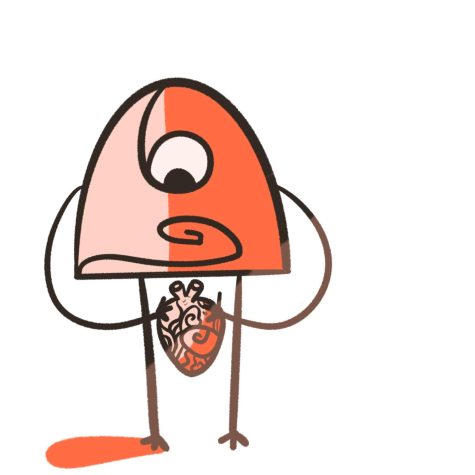 As soon as she dives into the water, she is at peace. The same water that got her through the most depressing moments in her life now sustains her during her last year of high school.
As soon as she dives into the water, she is at peace. The same water that got her through the most depressing moments in her life now sustains her during her last year of high school.
Rachel Pashturro, a senior at CHS, has done synchronized swimming since she was eight years old. Throughout her career, she has been on three synchronized swimming club teams, and is now on Pioneer’s team. Her favorite part of being on a team is how much it feels like a family as well as the connections she has made with her teammates through the sport. She believes that all the teams she has been on have been unique and tight-knit families.
While swimming, Pashturro’s mind is only focused on what she is doing in that moment. Synchronized swimming is similar to dance in the sense that while swimming, Pashturro is constantly counting the beats of music in her head, which helps her to stay on pace with her body and her mind.
“[Practice is] the one place I can go and I know that once I get there all I’m doing is [synchronized swimming],” Pashturro said. “I’m not thinking about what happened at school; I’m not thinking about who texted me; I’m just thinking about what I’m doing in the water and how I’m going to do better than I did last time.”
Synchronized swimming has helped fuel Pashturro’s journey towards self-discovery, but this did not come easily.
“I’ve struggled a lot in my years as a synchronized swimmer with coaching and peers on my team, but I learned to individualize myself and my needs as a swimmer and that helps me get through a lot of practices,” Pashturro said.
During practices, Pashturro has learned, through trial and error, that she improves the most by taking videos of herself swimming, watching every step and misstep and being self-aware while swimming.
As she has improved, though, her goals have changed. When Pashturro was younger, she watched girls on her team continue onto college teams, such as Louisiana State University, and wanted to be like them, but now she does not plan on swimming in college. This is for many reasons, but it ultimately comes down to her mental health.
“Growing up in a sport where the perfect image of a swimmer was skinnier and leaner, it was harder for me to accomplish what they were accomplishing,” Pashturro said. “I have grown into the idea that I don’t want to do it in college and it’s something that I can do on my own and know that it’s an escape.”
There are many ways society promotes unrealistic, skinny body types; this toxic body image expectation started affecting Pashturro at age 11.
“When I grew up and started realizing I don’t look like the other girls, it was eye opening,” Pashturro said. “When I moved here I started realizing, ‘Oh, I’m never really going to look like these girls; everybody looks different and that’s not my fault.’ But it wasn’t something that was very easily learned. It was definitely harder to achieve the things that they were achieving, and it was very hard as a young child to comprehend that there might be a way that I will never be as good as them or even better.”
Now, Pashturro feels she has finally earned her confidence, but this came with time, effort and struggle. Coming from competitive club teams, she is able to feel confident on Pioneer’s team and enjoy her time on the team without all the stress of club. During this journey, Pashturro realized that what really mattered about synchronized swimming, and life, was how she herself felt about it.
“It’s okay to not be better than other people because at the end of day you have to be better for yourself,” Pashturro said.
Pashturro is better for herself now, and she continues to become better. She has improved as a swimmer, but also as a person with a little help from synchronized swimming and her best friend.
A CHS junior expresses her emotions and passions through poetry.
 As the city’s sky grows dark and people get ready to sleep, Leila Bank is in her bed articulating her thoughts into words which then become poems. Bank found refuge words amidst the pandemic, which significantly impacted her mental health.
As the city’s sky grows dark and people get ready to sleep, Leila Bank is in her bed articulating her thoughts into words which then become poems. Bank found refuge words amidst the pandemic, which significantly impacted her mental health.
“I didn’t really realize how bad it was until last year,” Bank said. “And how bad it affected me, but now I’m working on healing.”
Bank uses poetry as a way to write down everything that crosses her mind: her feelings, experiences she has gone through, emotions attached to people and memories. Poetry offers an array of healing capabilities, and Bank finds that writing can help her understand her feelings and share them with the world.
“When they’re in your head, it’s hard to distinguish why you’re feeling the way you are,” Bank said.
Initially Bank hated poetry, disliking the confinement of schools’ poetry curriculums. The ‘correct’ or ‘incorrect’ way to interpret poetry and the feeling of teachers constantly looking for the right answer is something that made Bank feel invalidated. But during her sophomore year, she stumbled upon the poetry world in a more positive way through CHS’s poetry club.
“[My friends] both went to poetry club, so I just went with them and that was when I started actually writing poetry,” Bank said.
While the poetry Bank creates remains mostly personal, she finds comfort and enjoyment being in that space with others who create poetry as well.
“Even though poetry is really for yourself, I think whatever you write doesn’t have to make sense to anyone except for you,” Bank said. “There is something so nice about sharing [your poetry] with a group of people. It might not make sense to them, but they acknowledge that it’s not supposed to make sense to them.”
Writing for Bank typically begins with a single line stuck in her head— which she immediately writes down. Undoubtedly, the rest of the poem comes along after it. Metaphors, repetition and thinking visually are all a part of Bank’s process.
“Whenever I think of a feeling it has a different physical feeling attached to it,” Bank said. “It’s sort of like how people think that math is red and science is green.”
In addition to trying to decipher her thoughts, Bank expresses her love for the feeling wheel discovering how helpful it is. Six core emotions (sad, mad, scared, joyful, powerful and peaceful) border the outside, while the inside wheels feature more specific emotions, such as shame, hostility, helplessness or pride. While poetry is a creative and emotional outlet for Bank, therapy has been a large help in Bank’s mental health journey. More often than not, poetry and therapy intertwine as Bank recites her poetry to her therapist.
“I love reading them to her because a lot of the time, I don’t know how to articulate what I’m feeling with words that are supposed to make sense,” Bank said. “I read them to her so that she understands [what I feel] because she’s also a creative person.”
Length varies depending on what Bank chooses to write about. Longer poems are written when she’s undergone an experience that changed her outlook on things. For example, Bank used her experience from last year’s forum day to write a poem about changing perspectives. At other times, smaller length poems can sometimes consist only of two lines.
“Some people would say that’s not enough for a poem, but I disagree,” Bank said. “A poem can be whatever you want it to be.”











